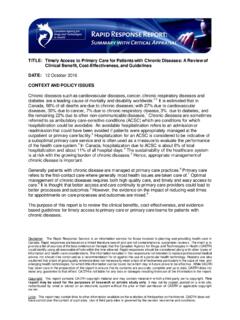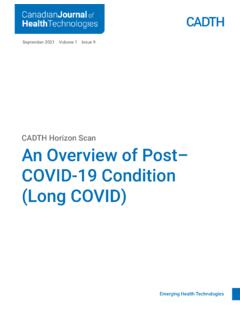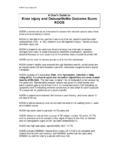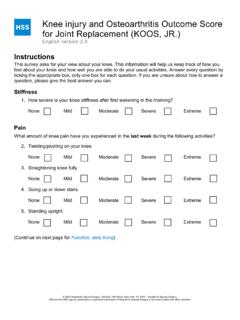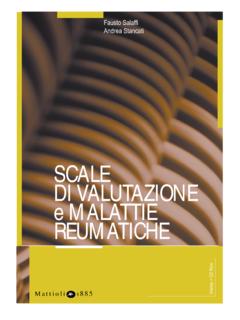Transcription of Issues in Emerging Health Technologies - CADTH.ca
1 The Canadian Agency for Drugs and Technologies in Health (CADTH) is funded by Canadian federal, provincial and territorial governments. ( ) Intra-Articular Hyaluronic Acid (Viscosupplementation) for Hip Osteoarthritis issue 98 May 2007 Issues in Emerging Health Technologies Summary 9 In viscosupplementation, a glycosaminoglycan called hyaluronic acid (HA) is administered via intra-articular injection to patients with osteoarthritis (OA). 9 Two systematic reviews found that HA for hip OA may relieve pain and improve function. Randomized controlled trials had differing results. Uncontrolled studies suggest that there are moderate improvements regarding pain and function for three to six months after HA injection. 9 There is no evidence regarding the cost-effectiveness of this therapy. 9 No serious adverse events have been reported after intra-articular injection of HA for hip OA.
2 9 The best available evidence suggests that HA may offer symptomatic relief in patients with mild to moderate hip OA for whom other conservative therapies are contraindicated or have failed. Currently, there is insufficient good quality evidence to determine this conclusively. The Technology Hyaluronic acid or hyaluronan (HA) is a glycosaminoglycan (GAG) composed of glucuronic acid and glucosamine in a polysaccharide of varying lengths and molecular weights. At high molecular weights, HA is viscoelastic, aiding weight-bearing joints in lubrication, shock absorption, and fluid retention during The mechanism of action is poorly understood, but the effects may be due to regulation of cartilage synthesis, inhibition of inflammatory cytokines and nociception (the ability to feel pain), and stimulation of natural HA synthesis. These effects may depend on the molecular weight of the HA This bulletin focuses on the evidence regarding its use for hip osteoarthritis (OA) and complements an earlier bulletin on HA for knee Regulatory Status In Canada, the first HA products for osteoarthritis were licensed in 1999, and several are available.
3 Some are licensed for use only in specific joints, such as the knee. Other HA products have broader Health Canada licensing that covers use in the knee and other synovial joints, such as the hip. These agents include Durolane (Q-Med AB), Hyalgan (Fidia Farmaceutici SpA), NeoVisc (Stellar Pharmaceuticals), Orthovisc (Anika Therapeutics, Inc.), Ostenil (TRB Chemedica), Suplasyn (Bioniche Teoranta), and Synvisc (also known as Hylan G-F 20, Genzyme Corporation).3 These products are regulated by Health Canada as class III or class IV medical devices, and sold as pre-filled single-use 2 mL (3 mL for Durolane) HA products are divided into low [ to megadaltons (MDa)] and high (6 to 7 MDa) molecular weights; Durolane, Orthovisc, and Synvisc are generally considered to be of higher molecular Patient Group OA is the most common joint disorder in the world.
4 Hip OA, which is second to knee OA in prevalence throughout North America and western Europe, is estimated to affect 3% to 11% of adults >35 years old, 7% to 25% of white European adults >55 years old, and 10% to 15% of adults >70 years The risk factors that may increase the likelihood of developing hip OA include obesity; excessive or repetitive physical activity; altered walking biomechanics secondary to trauma, injury, or other causes; and hip Although the pathogenesis of OA is incompletely understood, cartilage degradation is a hallmark of the Cartilage changes may be related to the loss of synovial fluid viscoelasticity, possibly due to decreased concentrations and molecular weights of Hip OA is often symptomatic, marked by a gradual development of pain, stiffness, and decreased function, which can restrict the activities of daily living and impair quality of ,9 Although the severity of hip OA varies, most patients will eventually need total joint arthroplasty (hip replacement)
5 For symptomatic and functional The radiological findings include joint space narrowing, osteophyte formation, and subchondral sclerosis, although such findings may not correlate with the self-reported outcome measures of disease Current Practice Many therapies are available for the symptomatic relief of hip OA. These include non-pharmacological (education, The Canadian Agency for Drugs and Technologies in Health (CADTH) is funded by Canadian federal, provincial and territorial governments. ( ) exercise, walking aids, complementary therapies, weight loss), pharmacological [non-steroidal anti-inflammatory drugs (NSAIDs), cyclooxygenase (COX-2) inhibitors, acetaminophen, opioids, and other analgesics], injection (corticosteroid and HA), and surgical (osteotomy and total joint arthroplasty) Evidence-based clinical practice guidelines for the management of hip OA recommend a combination of treatments based on hip risk factors, general risk factors, level of pain intensity, disability and handicap, location and degree of structural damage, and patients The preferred approach is to start treatment with acetaminophen and progress to NSAIDs or COX-2 inhibitors, opioids, guided intra-articular (IA) corticosteroids, osteotomy or other joint-preserving surgeries, and total joint arthroplasty in those with refractory pain or disability.
6 The degree of adherence to these clinical practice guidelines in Canada is unknown. The Evidence Clinical studies that have examined the efficacy of HA products for hip OA include two systematic reviews,17,18 two randomized controlled trials (RCTs),12,13 and several uncontrolled ,14-16,19,20 Two studies were funded by manufacturers,6,7 and one by research Other studies did not report the funding sources. A systematic review of viscosupplementation with HA or its derivatives for patients with hip OA uncovered nine studies with a total of 287 participants (including six studies6,7,13-16 that are discussed in this bulletin).17 Five studies with 141 participants treated with one to three injections of Synvisc reported an overall success rate of approximately 50% after three to 12 months. One study of 31 participants each treated with one Durolane injection reported improvements in pain (59%) and disability (47%) after three months.
7 One study of 44 participants each treated with three to five low molecular weight HA injections (product name unspecified) reported that 68% experienced effective pain relief after six months. One trial of 28 participants each treated with one to three Hyalgan injections reported a 28% improvement in VAS (visual analogue score) pain and 48% reduction in NSAID use. The only RCT13 reported improvements in pain and disability with low (Ostenil) and high (Synvisc) molecular weight HA products, and no difference in efficacy between the two products. The systematic review concluded that although available evidence suggests the therapy may be effective, there is insufficient evidence to determine this conclusively. A second systematic review of HA for patients with hip OA identified eight studies with >20 participants and a follow-up >1 week (including six studies6,7,12-14,16 and a systematic review).
8 17,18 The uncontrolled studies reported improvements in pain (43% to 84%), and in the Western Ontario and McMaster (WOMAC)/Lequesne indices (28% to 59%). The latter are commonly used, validated OA outcome measures. Two of the five studies included additional therapies. One RCT13 compared HA products of different molecular weights, and reported significant improvement in pain and disability with no differences between the two HA groups. One RCT12 compared HA to corticosteroids and placebo, and reported a higher proportion of respondents in the HA and corticosteroid groups after 14 and 28 days (p values not reported). The review reported that conclusive results regarding the efficacy of HA for hip OA could not be obtained without placebo-controlled studies. The review concluded that although evidence suggests that HA may improve pain and function in hip OA, its use should be restricted to patients in whom other treatments have failed, given the weakness of the available evidence.
9 In one RCT, 104 participants with hip OA received three weekly IA injections of Hyalgan (n=34), one corticosteroid followed by two placebos (n=34), or saline (n=36).12 The primary outcome was VAS pain on walking after 14 days, 28 days, and 90 days. In the Hyalgan group, VAS pain on walking was (mean SD) at baseline, with mean [95% confidence interval (CI)] improvements of 10 ( 18 to 2) after 14 days, 11 ( 19 to 3) after 28 days, and 11 ( 19 to 3) after 90 days. In the corticosteroid group, these values were , 12 ( 20 to 4), 15 ( 23 to 7), and 9 ( 16 to 1). In the saline group, they were , 2 ( 5 to 9), 1 ( 8 to 7), and 5 ( 13 to 2). The effect size for corticosteroid versus saline was (95% CI to ) and (95% CI to ) for HA versus saline. The effect size was not provided for HA versus corticosteroid. The peak effect was noted after 14 days.
10 There were no significant inter-group differences in any outcomes after 90 days (Hyalgan versus saline p= , Hyalgan versus corticosteroid p> , corticosteroid versus saline p= ). The second RCT compared the efficacy of three weekly injections of Ostenil (n=25) or Synvisc (n=18) in 43 participants with hip OA. Thirteen participants had bilateral OA, for a total of 56 hips (Ostenil=32, Synvisc=24).13 The primary outcomes were VAS pain, WOMAC index, and Lequesne index measured after one, three, and six months. The VAS pain (mean SD) for Ostenil versus Synvisc groups at baseline, one month, three months, and six months was versus , versus , versus , and versus This is an improvement of 38% versus 40% from baseline to six months. The Lequesne index (mean SD) for the Ostenil and Synvisc groups at baseline, one month, three months, and six months was versus , versus , versus , and versus This is an improvement of 43% versus 40% from baseline to six months.

